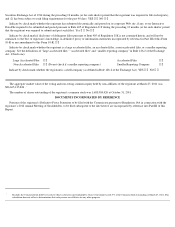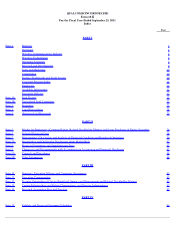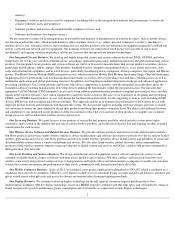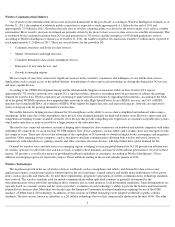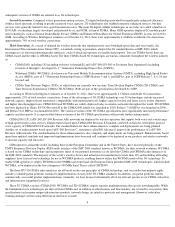Qualcomm 2011 Annual Report Download - page 13
Download and view the complete annual report
Please find page 13 of the 2011 Qualcomm annual report below. You can navigate through the pages in the report by either clicking on the pages listed below, or by using the keyword search tool below to find specific information within the annual report.
certain freedom of operation with respect to each party’s integrated circuits business. In every case, these agreements expressly reserve the right
for QTL to seek royalties from the customers of such integrated circuit suppliers with respect to such suppliers’ customers’ sales of CDMA-,
WCDMA- and OFDMA-based cellular devices into which such suppliers’ integrated circuits are incorporated.
We face competition in the development of intellectual property for future generations of digital wireless communications technology and
services. On a worldwide basis, we currently compete primarily with the GSM/GPRS/EDGE digital wireless communications technologies.
GSM has been utilized extensively in Europe, much of Asia other than Japan and South Korea, and certain other countries. To date, GSM has
been more widely adopted than CDMA; however, CDMA technologies have been adopted for all 3G wireless systems. In addition, most GSM
operators have deployed GPRS, a packet data technology, as a 2G bridge technology, and a number of GSM operators have deployed EDGE.
However, the majority of GSM operators have already augmented their networks with 3G WCDMA and HSPA. A limited number of wireless
operators have commercially deployed and other wireless operators have started testing OFDMA technology (e.g., LTE, WiMAX), a multi-
carrier transmission technique not based on CDMA technology, which divides the available spectrum into many carriers, with each carrier being
modulated at a low data rate relative to the combined rate for all carriers. According to GSA, in its October 2011 reports, 185 operators have
committed to deploy LTE networks, an OFDMA-based technology. We have invested in both the acquisition and the development of OFDMA
technology and intellectual property. We expect that upon the deployment of OFDMA-based networks, the products implementing such
technologies generally will be multimode and will also implement CDMA-based technologies. The licenses granted under our existing CDMA
license agreements generally cover multimode CDMA/OFDMA devices, and our licensees are obligated to pay royalties under their CDMA
license agreements for such devices. Further, 13 companies (including LG, Nokia and Samsung) have royalty-bearing licenses under our patent
portfolio for use in OFDMA products (that do not implement any CDMA-based standards).
Qualcomm Wireless & Internet Segment (QWI). QWI revenues comprised 4%, 6% and 6% of total consolidated revenues in fiscal 2011 ,
2010 and 2009 , respectively. The four divisions aggregated into QWI are:
Qualcomm Internet Services (QIS). The QIS division offers a set of software products and content enablement services to support and
accelerate the growth and advancement of wireless data products and services. QIS offers Brew platform products and services for wireless
applications development, device configuration, application distribution and billing and payment. Brew platform services are offered by wireless
operators worldwide, reaching a base of more than 250 million devices through more than 70 device partners. In addition, QIS has launched its
Plaza Retail offering with AT&T as the distribution system for its Brew-based devices. We also offer Xiam wireless content discovery and
recommendation products to help wireless operators improve usage and adoption of digital content and services by presenting relevant and
targeted offers to customers across all digital channels. This recommendations technology is offered as a standalone product, as well as
integrated as part of our core product offerings (i.e., Brew platform and Plaza), to help wireless operators spur wireless data growth. The QChat
product enables one-to-one (private) and one-to-many (group) push-to-talk calls over 3G networks. The technology also allows over-the-air
upgrades of mobile device software, management of group membership by subscribers and ad-hoc creation of chat groups. QChat uses Voice
over Internet Protocol (VoIP) technologies, thereby sending voice information in digital form over IP-based data networks in discrete packets
rather than the traditional circuit-switched protocols of the public switched telephone network.
The QIS division develops and sells business-to-business products and services through a sales and marketing team headquartered in San
Diego, California with offices worldwide. The QIS sales and marketing strategy is to enter into agreements with companies by providing
comprehensive technology and services that combine wireless Internet, data and voice capabilities. We have numerous current and emerging
competitors for each of our products and services whose relative degree of success may adversely impact our margins and sales volumes.
Competing offerings to the Brew and Plaza products include device manufacturer application and widget stores, such as Apple’s App Store for
the iPhone platform, operator-focused application and widget retailing and content distribution products and direct-to-consumer mobile
storefronts. Additionally, specialized software and service providers may offer key components of a complete mobile content retailing product to
wireless operators or device manufacturers seeking to build their own branded offerings internally. Our Xiam content discovery and
recommendations product faces competition from a small number of wireless operator-focused product providers and from emerging Web-
based
content recommendations engines. Additionally, some larger software providers and device manufacturers may attempt to build competing
recommendations products internally. Our QChat product competes with numerous push-to-talk services (PTT), including iDEN, which is used
principally in the United States and Latin America. QChat has now replaced iDEN as Sprint’s PTT service, with devices being rolled out under
the “Sprint Direct Connect” brand. The PTT services business is nascent outside of the United States with several competing standards- and non-
standards-based technologies.
Qualcomm Enterprise Services (QES ). The QES division provides equipment, software and services to enable companies to wirelessly
connect with their assets and workforce. QES offers satellite- and terrestrial-based two-way wireless connectivity and position location services
to transportation and logistics fleets and other enterprise companies that permit customers to track the location and monitor performance of their
assets, communicate with their personnel and collect data. The QES
8


